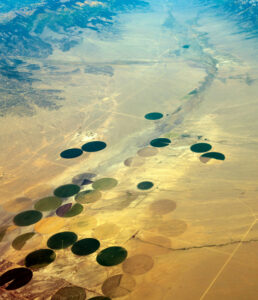The Valley sits on top of one of the largest aquifers in North America. It holds one billion acre-feet of water that is completely renewable – this means the water recharges at a rate it renews itself every year.
This vast water resource, however, has a section that is shallow. Current water levels are not sustainable. This shallow portion of the aquifer supplies the Valley with much of its water for agriculture and domestic use, which is why low levels are problematic. Ongoing unsustainable water levels mean an unsustainable economy.
If the smaller aquifer doesn’t get healthier, the state of Colorado could force all wells in one of the Valley’s main sub-districts to shut down. The state engineer, who works within Colorado’s Department of Natural Resources and reports to the Governor, has forewarned the Valley that curtailment will happen if water levels do not improve; and two-thirds of local residents are concerned this warning could become the new reality.
The Renewable Water Resources project presents the Valley an alternative option to water curtailment.
Modern technology allows us to reach the water and improve our way of life for generations to come. If we access the billion-acre foot aquifer two thousand feet below the surface, we can heal the surface water and the shallow aquifer that has been tapped for generations.
And, the amount of water we would develop from the largest portion of the aquifer, 22,000 acre-feet, represents only 2.5 percent of its annual recharge.

Overview
- The RWR proposal would develop only 2.5 percent of the water in the large aquifer, or about 22,000 acre-feet.
- RWR holds senior water rights already, and is investing $68 million to pay farmers and ranchers who voluntarily wish to sell their water rights 3x the above market rate, allowing RWR to retire the desired goal of 31,000 acre-feet.
- Legal protections are in place to guarantee that more (or equal) water flows into the aquifer each year than is taken out. This means if we access 2.5 percent or 22,000 acre-feet of water from this renewable, billion-acre foot aquifer, we must retire 22,00 acre-feet of water. Colorado law mandates this. RWR is going one step further and retiring more water than is legally required to help the stressed unconfined, shallow aquifer.
- Farmers and ranchers are getting competitively paid in exchange for their water rights, 3x the market rate and on a voluntary basis.
- Additionally, RWR is creating a $50 million Community Fund which the local community can use to improve essential services like police, fire, health care, and schools. This equates to an infusion of about 3 to 4 million annually into the local economy.
How will the water be put to use?
- 22,000 acre-feet will be transported to the Front Range, helping the state avoid a looming water crisis as the state’s population is expected to double over the next three to four decades, according to estimates in the Colorado Water Plan.
- The remaining 9,000 acre-feet of retired water will go back into the San Luis Valley’s shallow aquifer, helping the Valley stave off water curtailment.
- The San Luis Valley is the only place in the state that has a “one-for-one” law. This means that if any water is proposed to be taken out, the equal amount of water must be retired at the same amount. The RWR project is proposing to retire MORE water than it aims to develop and ensuring farmers who voluntarily wish to sell their water rights get paid generously.
